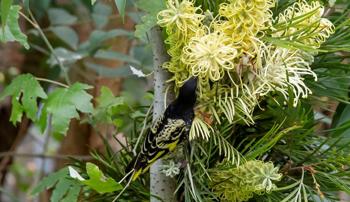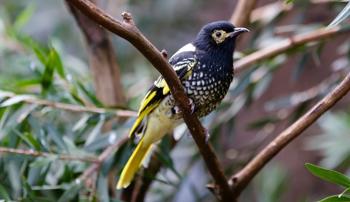Regent Honeyeater
With less than 250 birds left in the wild, the Regent Honeyeater is on the brink of extinction.
Once widespread through the woodlands of southeast Australia, this species has been in decline since the 1940s, and its soft, metallic chiming call is rarely heard anymore.
The attractive bird lives in dry, Box-Ironbark eucalypt forest and woodlands inland of the Great Dividing Range, with seasonal movements to coastal forests. Its core habitat is the most fertile areas along river valleys and flats, which provide more consistent food resources during periods of drought. These areas have largely been cleared for agriculture, with only small patches of core breeding habitat remaining in north-east Victoria, the Blue Mountains, and the northern Tablelands of NSW. The honeyeater feeds on the nectar of eucalypts and can travel long distances to follow the trees' seasonal flowering patterns. It also feeds on lerps, which are protective casing built on leaves by insects called psyllids.

The major threats
The loss of the Box-Ironbark forests is the major reason for the diminishing number of Regent Honeyeaters. The forests have been cut down for agriculture, suffered from dieback, and many large trees in the woodlands have been lost through forestry practices. Remaining habitat is threatened from climate changes via drought and bushfire.

The plan for fighting extinction
Melbourne Zoo is breeding Regent Honeyeaters to help with the recovery of this species, as part of the captive release program led by Taronga Conservation Society. Zoos Victoria is looking to further boost its contribution to the captive release program in the future.
How you can help
- Raise community awareness and support for the Regent Honeyeater.
- Join the Regent Honeyeater Project and take part in tree planting days.
- Visit our zoos to support our work to fight extinction.
- And donate if you can. We are a not-for-profit organisation, so all donations go towards our conservation work.
- Discover more about local conservation events and join the growing number of wild activists taking action for local wildlife.
Is your classroom learning about the Regent Honeyeater?
Browse through our collection of animal teaching and learning resources for students. These include animal toolkits, e-books, Ask a Zoo Expert resources, video showcases and real-world examples to support the VCE Study Design.
